#guide to mesa verde national park
Explore tagged Tumblr posts
Text
Plan Your Adventure: A Complete Mesa Verde National Park Guide
A thousand years ago, the Four Corners region was home to the Ancestoral Puebloans. Here, they built elaborate and beautiful dwellings into the cliffsides. In my Mesa Verde National Park guide, I show you how to plan a trip to this amazing place.

View On WordPress
#can you tour mesa verde on your own#guide to mesa verde national park#guided tours of mesa verde#hotel in mesa verde national park#mesa verde activities#mesa verde best time to visit#mesa verde cliff dwellings photos#mesa verde colorado pictures#mesa verde guided tour#mesa verde guided tours#mesa verde hotel in park#mesa verde hotels colorado#mesa verde images colorado#mesa verde motel#mesa verde national park guide#mesa verde national park guided tours#mesa verde national park hotels nearby#mesa verde national park self guided tours#mesa verde national park visitor guide#mesa verde park photos#mesa verde photos#mesa verde self-guided tours#mesa verde temperature#mesa verde temperatures by month#mesa verde tips#mesa verde tour guide#mesa verde travel guide#mesa verde visitor guide#ranger guided tours at mesa verde#self guided tours of mesa verde
0 notes
Text

Experience the beauty and wonder of Mesa Verde National Park like never before. Our self-guided drive tour allows you to explore this ancient and historic park at your own pace, with the convenience of a personal tour guide on your phone.
0 notes
Text
#Mesa Verde National Park#Ancestral Puebloans#Cliff Palace#Balcony House#Long House#Spruce Tree House#hiking trails#wildlife spotting#stargazing#ranger-guided tours#Far View Lodge#Cortez hotels#Mancos lodging#Durango accommodations#accessibility tips#park regulations#visitor tips#American archaeology#cultural heritage#national park travel
0 notes
Text
Exploring Ancient Wonders: Hiking in Mesa Verde National Park
Discover the Mysteries of the Past As the sun casts its golden glow over the rugged landscapes of Mesa Verde National Park, you’ll find yourself stepping into a world where time has woven tales of ancient civilizations. This unparalleled destination invites adventure enthusiasts to embark on a journey through history, to hike and trek amidst the remnants of an ancient Puebloan culture. Get ready…
View On WordPress
#Adventure Destinations#Adventure Travel#ancient civilizations#ancient ruins#archaeological wonders#cliff dwellings#Colorado adventure#cultural heritage#exploring history#guided tours#heritage sites#Hiking and Trekking#hiking trails#historical sites#Mesa Verde National Park#national monuments#National Parks#nature adventure#nature and culture#Outdoor Activities#outdoor enthusiasts#Outdoor Exploration#preservation#Puebloan culture#travel inspiration#wilderness exploration
0 notes
Text


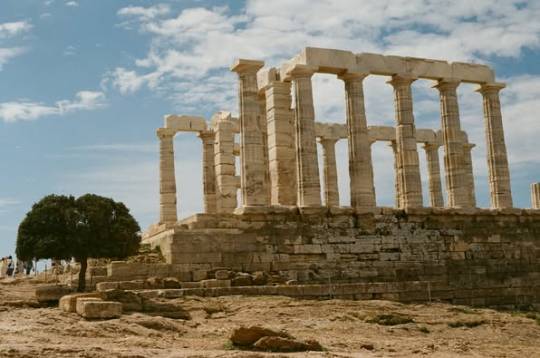



History buffs and travel enthusiasts, this one's for you! Have you ever dreamt of walking through ancient cities or marvelling at age-old structures? Well, you don't have to embark on an Indiana Jones-style expedition to experience the thrill of archaeology. Here are 5 incredible archaeological sites that are surprisingly accessible: Pompeii, Italy: Travel back to 79 AD and explore the frozen-in-time Roman city of Pompeii. Witness the everyday lives of its inhabitants preserved by volcanic ash, from homes and shops to haunting body casts. Numerous tours are available, and Pompeii is easily reached by train or car from Naples or Rome. Acropolis, Athens, Greece: Ascend the sacred hill that housed the Parthenon, a temple dedicated to the goddess Athena. Explore the ruins of other significant structures like the Propylaea gateway and the Erechtheion temple. Athens is a well-connected city with a robust tourist infrastructure, making the Acropolis a breeze. Chichen Itza, Mexico: Immerse yourself in the Mayan civilization at Chichen Itza, a sprawling complex featuring the iconic pyramid-temple of Kukulkan (El Castillo). Explore other structures like the Temple of Warriors and the Ball Court, all remnants of a powerful Mayan city. Chichen Itza is close to popular tourist destinations in the Yucatan Peninsula, making it a convenient stop. Colosseum, Rome, Italy: Step into the gladiatorial arena of the Roman Empire at the Colosseum. This awe-inspiring amphitheatre is a testament to Roman engineering and entertainment. Guided tours provide a glimpse into the history of gladiatorial combats and public spectacles. The Colosseum is a must-see for any visitor with its central location in Rome. Mesa Verde National Park, Colorado, USA: Journey back to the cliff dwellings of the Ancestral Puebloan people at Mesa Verde National Park. Explore cliff houses and villages built into the canyon walls, offering a sense of the ingenuity and lifestyle of this ancient civilization. The park offers tours and ranger-led programs and is easily accessible by car.
#travel#travel destinations#europe#italy#greece#mexico#archeology#history#history travel#usa#travel inspiration
3 notes
·
View notes
Text
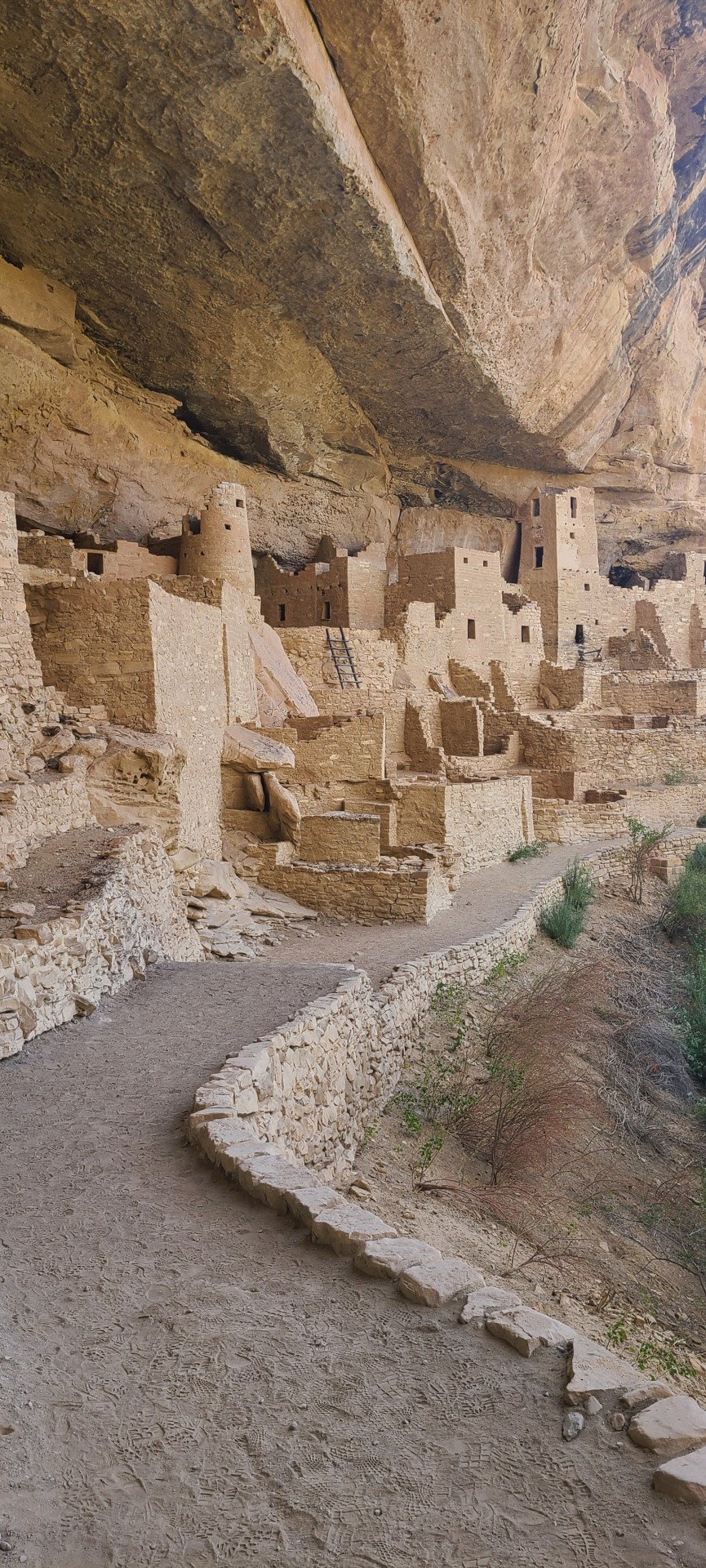
Mesa Verde National Park, CO (Sept 2023)
Cliff Palace. You need a special tour guided by a ranger to access any of the cliff dwellings, and this hike involves climbing several long ladders along with many strangers. A fascinating, powerful place that has led me to researching more of the indigenous history of the place that I live.
8 notes
·
View notes
Text


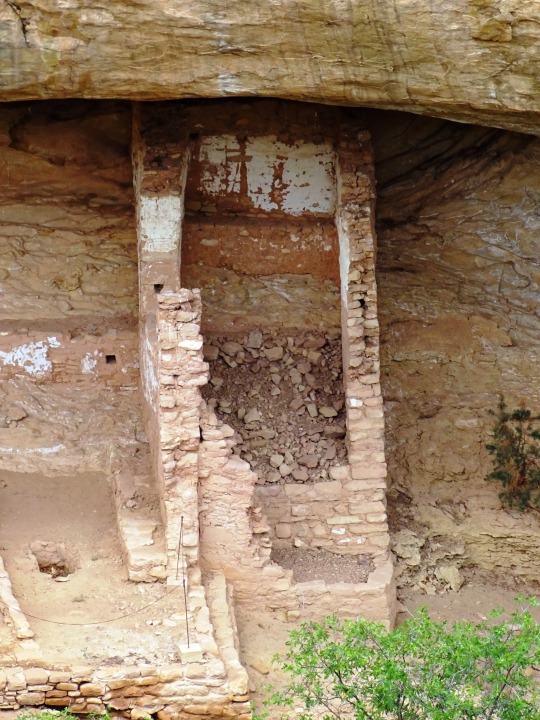
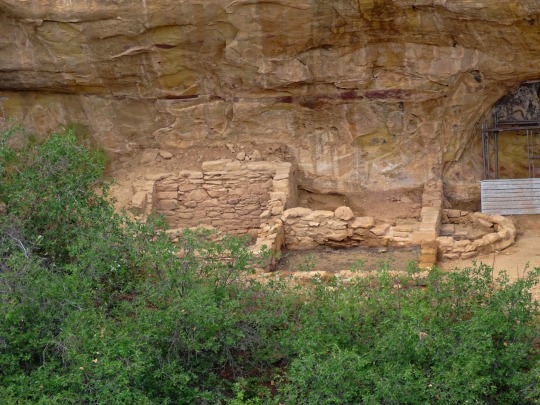

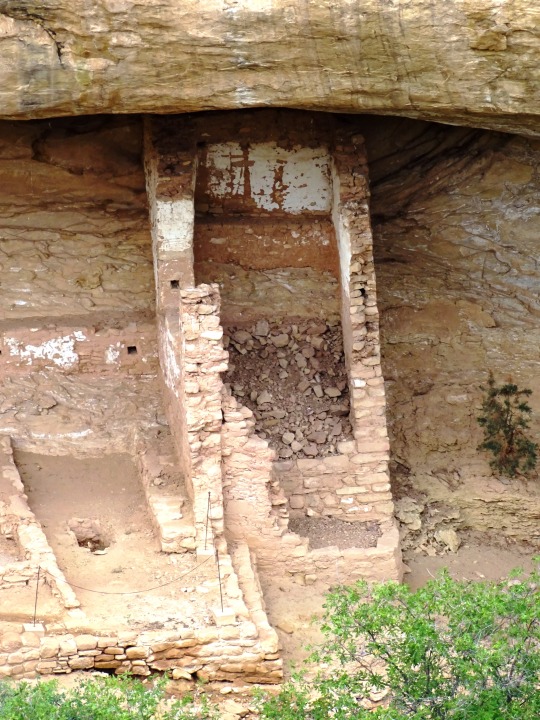
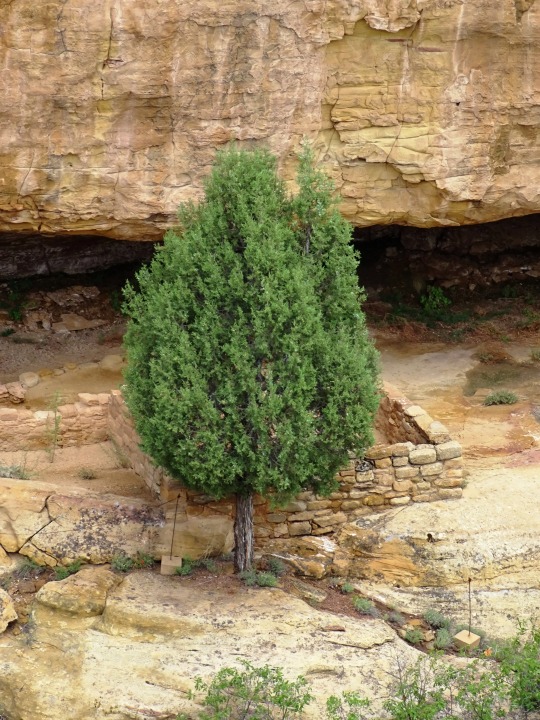
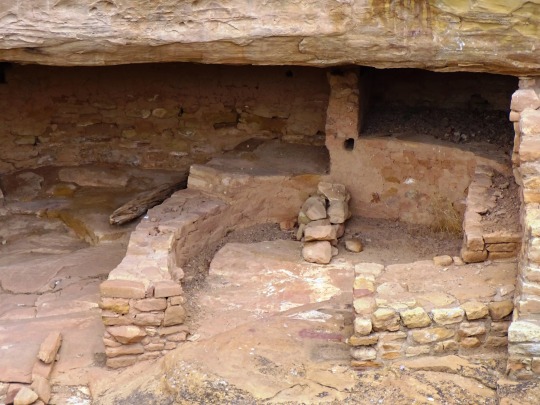
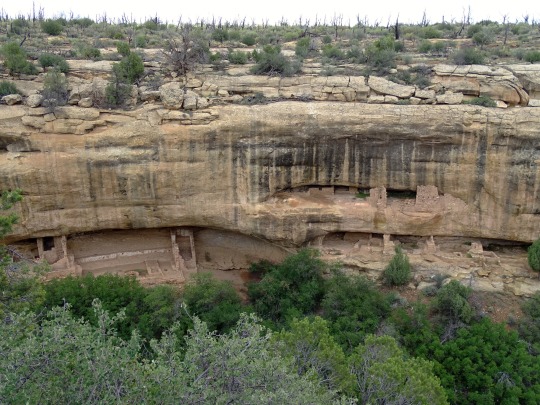
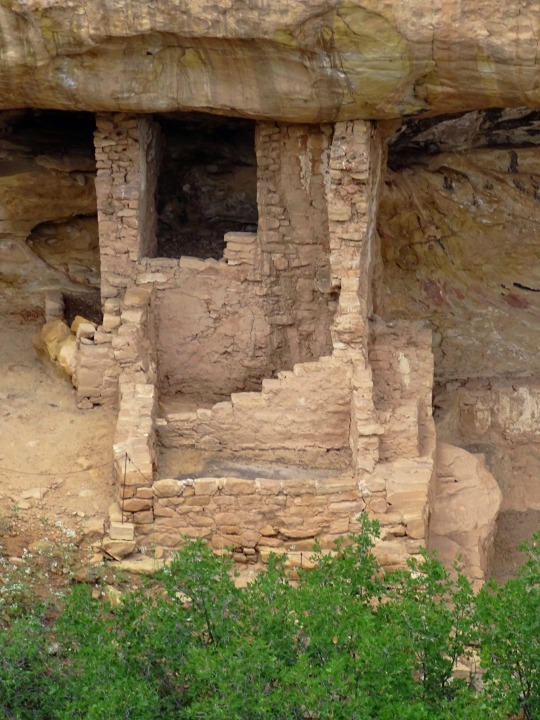
Mesa Verde National Park (No. 20)
The entrance to Mesa Verde National Park is on U.S. Route 160, approximately 9 miles (14 km) east of the community of Cortez and 7 miles (11 km) west of Mancos, Colorado. The park covers 52,485 acres (21,240 ha) It contains 4,372 documented sites, including more than 600 cliff dwellings. It is the largest archaeological preserve in the US. It protects some of the most important and best-preserved archaeological sites in the country. The park initiated the Archaeological Site Conservation Program in 1995. It analyses data pertaining to how sites are constructed and utilized.
The Mesa Verde Visitor and Research Center is located just off of Highway 160 and is before the park entrance booths. The Visitor and Research Center opened in December 2012. Chapin Mesa (the most popular area) is 20 miles (32 km) beyond the visitor center. Mesa Verde National Park is an area of federal exclusive jurisdiction. Because of this all law enforcement, emergency medical service, and wildland/structural fire duties are conducted by federal National Park Service Law Enforcement Rangers. The Mesa Verde National Park Post Office has the ZIP code 81330. Access to park facilities vary by season. Three of the cliff dwellings on Chapin Mesa are open to the public. The Chapin Mesa Museum is open all year. Spruce Tree House is also open all year, weather permitting. Balcony House, Long House and Cliff Palace require tour tickets for ranger-guided tours. Many other dwellings are visible from the road but not open to tourists. The park offers hiking trails, a campground, and, during peak season, facilities for food, fuel, and lodging; these are unavailable in the winter.
The park's early administrative buildings, located on Chapin Mesa, form an architecturally significant complex of buildings. Built in the 1920s, the Mesa Verde administrative complex was one of the first examples of the Park Service using culturally appropriate design in the development of park facilities. The area was designated a National Historic Landmark District in 1987.
Source: Wikipedia
#Mesa Verde National Park#Ancestral Puebloans#Montezuma County#Native American history#Mountain West Region#archaeology#travel#original photography#vacation#tourist attraction#landmark#architecture#landscape#countryside#summer 2022#USA#Colorado#nature#flora#desert#desert varnish#geology
5 notes
·
View notes
Text
That Mesa Verde story is especially haunting to me because once when I was around eight to ten years old, my family went on a trip and one of our stops was the Mesa and my dad and I made the exact same mistake.
And we weren't prepared- we had planned on just seeing a couple of the closest ruins. We went to the Spruce Tree House and had meant to head right back to the museum, but there was a sign that said petroglyph trail and, not realizing that the trail was a HIKE and not just a casual walking distance area significant to the ruins, we ended up taking a 2.4 mile strenuous hike we had not planned and had not prepared for.
I was in a sundress and flip flops, I wasn't wearing sunglasses because we couldn't afford perscription sunglasses and I needed to see more than a foot in front of me, neither of us had sunscreen, and there was only one bottle of water between the two of us. We had to stop several times trying to follow that trail because I physically could not keep up with my father.
The fact that we actually managed to make the whole fucking thing is a goddamn miracle and I so vividly remember the terror I felt being lost, and hot, and thirsty, and exhausted, just wanting to go home, that to this day I refuse to so much as LOOK at a trail without a guide in front of me.
Do not fuck around with national parks ffs.
Any conspiracy theory about people going missing in National Parks is automatically silly to me. Like "Why are National Parks such a hotbed of disappearances???" because they're full of idiots. You've got thousands of people who've never pissed outdoors in their life wandering around the woods/desert/mountain with zero experience and zero gear and zero understanding that this place can kill them. You don't see as many disappearances in wild areas because people don't go to them unless they have some background knowledge. Whereas you get tour buses full of old folks and suburban families shuttling people into National Parks 365 days a year. If you took the same amount of buffoons and dropped them in the actual wilderness the disappearances would be significantly higher than at the parks. Use your brain.
107K notes
·
View notes
Text
Colorado Attractions for Families: Fun-filled Adventures for All Ages
Colorado is a fantastic destination for families seeking unforgettable adventures. Discover the top Colorado attractions that are perfect for families in this exciting guide. From the iconic Pikes Peak and the historic Mesa Verde National Park to the fascinating Denver Museum of Nature & Science, there's no shortage of things to see and do.
Explore the unique landscapes of the Garden of the Gods or embark on a thrilling wildlife safari at the Cheyenne Mountain Zoo. With an abundance of outdoor activities, educational experiences, and breathtaking scenery, Colorado offers an unforgettable vacation for the whole family.
Link: Colorado Attractions for Families
#FamilyAdventuresColorado#ExploreWithKidsCO#ColoradoAttractions#OutdoorFunForFamilies#WildlifeEncounters#RockyMountainExplorers#FamilyFriendlyMuseums#ScenicColorado#EducationalExperiences#FamilyBondingTime
1 note
·
View note
Text
Saturday, May 15, 2021 Canadian TV Listing (Times Eastern)
WHERE CAN I FIND THOSE PREMIERES?: SWEET CAROLINA (W Network) 9:00pm RACE FOR THE VACCINE (CNN) 9:00pm NEW TO AMAZON PRIME/CRAVE/NETFLIX CANADA/CBC GEM: AMAZON PRIME BLACK FOX: AGE OF THE NINJA HE WHO CAN’T MARRY (Season 1-2) JUHO 2405 REASON OF MY DEATH (Season 1) LET’S ENJOY KENYA SAFARI LIKE A POPULAR ONLINE TOUR! (Season 1) TUCK JAGDISH MLS SOCCER (TSN4) 1:00pm: NYCFC vs. Toronto FC (TSN4) 7:00pm: Atlanta vs. CF Montreal NBA BASKETBALL (TSN) 2:30pm: Heat vs. Bucks (TSN5) 3:00pm: Lakers vs. Pacers (TSN/TSN5) 5:30pm: 2021 Basketball Hall of Fame Enshrinement (TSN) 10:30pm: Hornets vs. Knicks NHL HOCKEY (SNWest/SNOntario/SNEast/SNPacific) 3:30pm: Canucks vs. Oilers (SN/CBC/Omni) 7:00pm: Bruins vs. Capitals - Game #1 2021 PREAKNESS STAKES (TSN3) 5:00pm MLB BASEBALL (SN1) 7:00pm: Phillies vs. Jays RUGBY (TSN2) 8:00pm: Toronto Arrows vs. Houston SaberCats A BUNDLE OF TROUBLE: AN AURORA TEAGARDEN MYSTERY (CTV) 8:00pm: Aurora Teagarden and her boyfriend Martin are thrilled when they get an unexpected visit from his niece and her new baby. Their excitement is short lived when his niece disappears and the baby is left behind. YUKON HARVEST (APTN) 8:00pm: Chronicling the adventures of Indigenous hunting guides in the Yukon, Canada. BEWARE OF MOM (Lifetime Canada) 8:00pm: A woman tries to save her teenage daughter from a wild neighborhood mother who wants to steal her away. MINOR DETAILS (Super Channel Heart & Home) 8:00pm: Four girls join forces to find a solution to a mysterious illness that has befallen students and faculty at their school. GOING NATIVE (APTN) 8:30pm: After exploring Colorado's Mesa Verde National Park and its 800-year-old Pueblo cave dwellings, Drew then reveals how cutting-edge Indigenous architects are drawing lessons, and designs, from their own tribal past. SOUND OF METAL (Crave) 9:00pm: A drummer's life gets turned upside down when he suddenly loses his hearing. RUPAUL’S DRAG RACE DOWN UNDER (Crave 3) 9:00pm: The queens are split in two, as they compete in the ultimate girl group sing-off. THE DEVIL YOU KNOW (Investigation Discovery) 10:00pm (SEASON PREMIERE): When doomsday prepper Steve Mineo is expelled from Sherry Shriner's cult, he tries to protect his girlfriend from online attacks and winds up dead. HOT ONES (Global) 1:00am/1:30am: Guy Fieri/Neil deGrasse Tyson
#cdntv#Cancon#canadian tv#canadian tv listings#yuki tsunoda#going native#rupaul's drag race down under#mls soccer#nba basketball#nhl hockey#MLB Baseball#rugby
1 note
·
View note
Text
Day Five -- A long-held goal realized: Mesa Verde
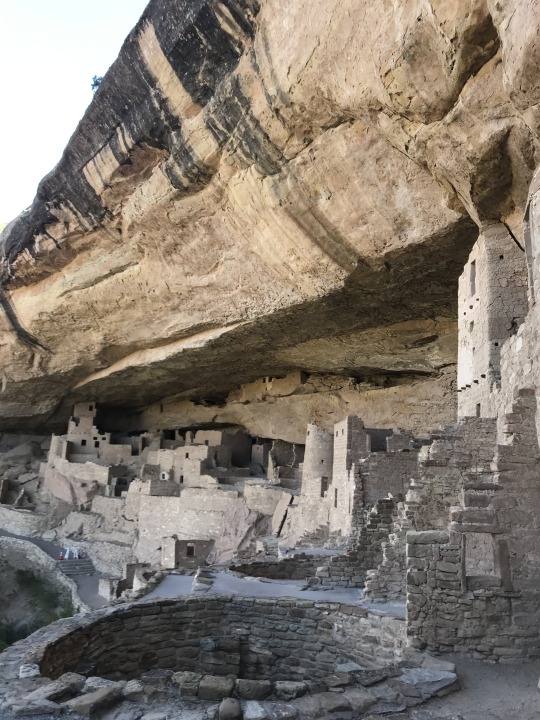
Up close and personal -- my first view of Cliff Palace
I’m up early, hoping to arrive at the park as soon as it opens at 8 AM. After luxuriating in my hot tub last night, I washed out a few items and hung them to dry. I am now shocked to find that all of these items dried overnight. It would take two or maybe three days for them to dry under similar circumstances in Seattle. I cleverly deduce that this area must be very dry indeed. (Continue reading below.)
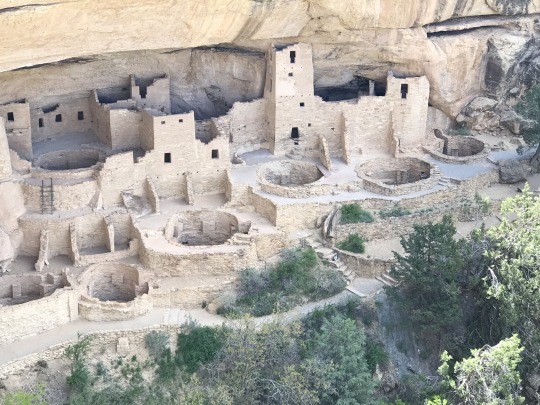
Cliff Palace from an overlook
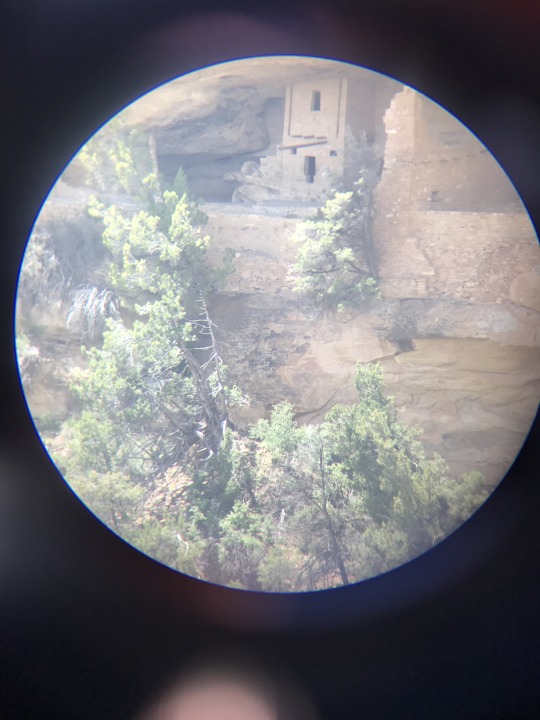
Balcony House through a telescope

Spruce Tree House
DAY FIVE -- A long-held goal realized: Mesa Verde
I eat a quick bowl of oatmeal at Holiday Inn’s free breakfast and head out into a lovely sunny morning. I’ve wanted to visit Mesa Verde for more than 20 years and intend to devote this entire day to it. The last time I drove through here on my way to visit my sister and her new twin girls (who are about to turn 21, OMG) I didn’t plan well enough and didn’t have time to tour the park, for which you need a minimum of three hours to see anything at all. I now plan to make up for that omission.
I stop at the Park Entrance Station where I get in a short line to buy a ticket for a ranger-led tour. There are three tours listed: Cliff Palace, Balcony House and Long House, however today only the Cliff Palace tour is available. Signs warn that the tour of Cliff Palace is very strenuous so I fret while waiting in line, worried that the tour might be more than I can handle. When it’s my turn to talk to the ranger selling tickets, I ask for more details about the tour. She tells me I will have to negotiate 4 ten-foot ladders and walk over uneven and rocky ground. I reason (under my breath) that if I managed to climb to the top of St. Paul’s Cathedral only six months ago, I should be able to manage this.
So you want a ticket? Yes, please. I expect it to be expensive, but the price is just $5.00. When I express surprise at the minimal fee, the ranger says, if you want to spend big money you can buy a tour from the private company that contracts out for us. She jerks her head in the direction of a desk manned by someone who does not appear to be a ranger. I consider this option briefly, but per the sign these tours are long (nine hours!) and involve being driven around the park in a huge bus (I hate being a captive audience) so I decide to explore the rest of the park on my own after seeing the Cliff Palace.
My tour is scheduled for 10:00 AM. After selling me a ticket, the ranger says I have plenty of time to get there as long as I don’t dawdle – it’s an hour-long drive to the top of the mesa. She gives me a map and marks the spot where the tour will begin. An hour! Yikes. I skip the exhibits and head out to my car.
At the park entrance, I point to the senior pass hanging from my rear-view mirror and ask the ranger if she needs anything else. At Canyonlands I was waved through on the strength of this pass, but at Mesa Verde I have to show an ID and submit my pass for close scrutiny. I suppose this is an indication of how popular this park is – nothing is taken for granted.
To get to the heart of the park, I now follow a road that winds 1500 feet up the side of the mesa. The elevation in Cortez is 6200 feet; now I will be climbing to over 8000. The road to the top of the mesa must be taken slowly as it is very narrow with hairpin turns. (For the first years of the park’s existence, this was a graded dirt, one-way road. Before a vehicle started up the road to the top of the mesa, a telephone call (from a phone box at the bottom) made sure no one was on their way down, then all downwards traffic was held until the caller arrived at the top. (I learned this fascinating fact by reading a book called “Our Trip to Mesa Verde 1922” that I purchased in the gift shop later.)
I drive straight to the meeting spot for the tour and am the first to arrive. Due to a recent rockfall that has closed the usual entrance, our tour will enter Cliff Palace at the same place we exit. Soon there are several of us waiting for the ranger to show up. I strike up a conversation with a couple of women who appear to be about my age and mention the fact that I am traveling alone. They are suitably impressed. I show off a little: travel when you want, where you want, I say, and they nod appreciatively. I briefly sketch out my route and mention that I stopped to see the Great Salt Lake. They want to know what I thought of it. The question feels loaded so I hedge a bit. Well it seemed quite nice this time, but my last visit wasn’t quite as positive. (Trying to say both that I liked it and also that I didn’t, so I can take my cue from their reaction. But I never quite decide what they think of the lake or why they asked. I get a sense that they might live near Salt Lake and are not terribly impressed.)
They ask if I have any sunscreen, so I get some out of my car. Then I ask if they have any ibuprofen as the headache I woke up with is unrelenting. They do. It’s a good trade and there are smiles all round. These brief friendly encounters are one of the best parts of travel. (I realize later that I was probably suffering from low-grade altitude sickness during my stay in Cortez and Mesa Verde. In spite of taking ibuprofen the headache stayed with me the entire day.)
Our tour guide shows up. At exactly 10 o’clock she leads us down a short trail to the ladders. She tells us we will go down one by one and after descending we are to follow the path to the right and join her near the ruins where we will wait for everyone to climb down and join us. There are four 10-foot ladders made out of rounded, bark-free, tourist-worn tree trunks about six inches in width and a yard long which although precipitous are fairly easy to negotiate. I make the mistake of taking my walking sticks with me (because we were warned that we would have to traverse uneven ground) and they make my descent much clumsier, clanking against the rungs of the ladder and even getting caught up behind them. I have to move carefully and make sure every step is secure and the sticks make it difficult as it seems I am untangling them constantly. Even with these issues, I’m not the slowest by any means, which is a relief. (Several are slower including a woman with acrophobia who takes so long to descend and needs so much help the ranger has to start the tour without her.)
After successfully negotiating the ladders I follow a well-worn trail around the rock face and suddenly the Cliff Palace ruins are before me – a sandstone city of towers, living and storage rooms, kivas and open work areas. It looks just like the photos I’ve studied and for some reason this seems incredible – a long-treasured wish suddenly coming true. After years of wanting to see this site now it’s right in front of me and I’m overwhelmed.
I find it impossible to see these structures and not also feel intrigued by the mysteries that can never be answered. Why did these ancient people move from the top of the mesa where they had lived from AD 550 to AD 1200 and down into the cliffs? Why did they suddenly abandon the cliff dwellings in AD 1300, leaving behind many prized possessions such as mats, ceramic vessels and stores of food? There are many theories, but it is impossible to answer these questions definitively. What an enigmatic and evocative place.
Our ranger is knowledgeable and enthusiastic. She tells us that Mesa Verde has been a national park since 1906 and that it was the first park established to protect cultural and archaeological treasures rather than natural wonders. The archaeological sites needed protection as they were increasingly being plundered by travelers and explorers. Even the man given credit for discovering the ruins – Richard Wetherill—is considered by some to be more plunderer than archaeologist.
The ruins are empty now, their contents scattered across the country in museums. It seems a shame that it isn’t possible to see the pottery and other artifacts in the place they originated. I promise myself that I will visit some of these museums in the near future, to get a better feel for the people who lived here.
But at least the ruins remain. Our guide tells us that Cliff Palace contains 150 rooms, 75 open areas, and 21 kivas. There are both round and square towers and many storage rooms and granaries. She shares some of the theories about the use of Cliff Palace – some believe it was a residence for several families, some believe it was largely a ceremonial site with a few people caring for it and living in residence. Some believe it was used strategically during conflict. When she talks about the reason the inhabitants abandoned these dwellings, she discusses factors that may have contributed to their decision – several years of drought in the years immediately before their departure, for instance. She concludes by saying she believes they moved on because, based on their culture and beliefs, it was simply time to go.
Although our guide has a wealth of knowledge about Mesa Verde and the people who lived here, (she tells us she has worked as an archaeologist in this area for years) she is too matter of fact for my liking. I long to hear someone speculate about the past and weave stories about the people who used to be called the Anasazi. (Researchers and archaeologists stopped using this term when they realized it was a Navajo word meaning ancient enemy.) The current and more accurate name for the people who lived in Mesa Verde is Ancestral Puebloans.
The tour ends and we now have to climb back up the ladders. It’s considerably harder than climbing down, even worse than I anticipated. I stop between each section of ladder and try to briefly catch my breath—briefly, because I don’t want to be obviously incapable – which has more to do with pride than anything else. There is no question that the altitude is affecting me, especially while climbing these four ten-foot ladders. When I get to the top I’m gasping, heart racing, and wishing I’d thought to bring along my inhaler, which I rarely need but could really use now.
There are several benches at the top of the ladders – placed strategically for tourists who need to stop and catch their breath. I’m surprised to see that it’s not only we older folks who need to rest after the climb—people 30 years younger than me are panting and gasping as well. The unfortunate woman with acrophobia is nowhere to be seen.
I return to my car, with plans to drive around the top of the mesa and see as much of the park as is possible in a day of touring. There is so much more to see – the park contains 5000 archeological sites, including 600 cliff dwellings. Of course, only a small fraction of these are available to tour – but even so, there is far more than can be seen in one day: Spruce Tree House, Fire House Ruins, Square Tower House Overlook, Oak Tree House Ruins, Sunset House, Balcony House, Mesa Top, Long House, Step House – the list goes on and on. I do my best and drive to as many of these as I can. One of the highlights of Mesa Verde is Balcony House, so I walk out about ¾ of a mile to a spot where you can view it from across a canyon. There is a telescope you can train on the site for a closer look and I manage to take a photograph through this telescope. (The round photo above.)
I also check out the Mesa Top ruins, where the Ancestral Puebloans lived hundreds of years longer than they lived in the cliff dwellings, and drive both the Cliff Palace and Mesa Top Loops, stopping frequently to walk to overlooks and examine excavated ruins.
It is late in the afternoon when I make it to the Chapin Mesa Archaeological Museum. Spruce Tree House Overlook is nearby and there is a lovely paved path on which you can walk down for a closer look but by this point I am so exhausted I don’t feel able to walk even this short distance. (For someone who can only manage a flying visit, this is definitely the place to go – The Spruce Tree House is an impressive site and easy to get to, plus it is within walking distance of a café, museum and bookstore. If you were pressed for time you could hit just this one area of the park.)
Although feeling very tired I manage to visit the bookstore, where I overdo it as usual and buy four (!) books about Mesa Verde because I am still longing for more – I want something I can take with me and savor after this day is over. Also, I hope the books will satisfy some of the curiosity I still feel about the people who lived here and their fate.
One of the books is simply for fun: a Nevada Barr mystery (this is a fun series with a female protagonist who is a ranger who moves from national park to national park, solving a different mystery in each. I had read the mystery set in Mesa Verde many years earlier – (so long ago I could no longer remember who-done-it.) It was fun to reread and this time around be able to recognize many of the landmarks and know that I had actually set foot in many of them!)
I also buy a very short tract written by three young women who visited the park in 1920 (they walked to Mesa Verde from their homes in Colorado), another book based on interviews with Marietta Wetherill, wife of Richard who excavated extensively here and in Chaco Canyon. My fourth book ends up being the best of the lot – I buy it because it appears to be a book that will satisfy my craving for more detailed information about the people who lived here -- a book that will bring those early days to life and provide answers or at least speculation about their lives and motivations: “House of Rain” by Craig Childs. The research and effort that went into his book is astounding. What a luxury to have someone do extensive research (including many long walks across the desert), interview archaeologists and scientists, and pull together all of these many threads of knowledge into a cohesive whole. Even better, Childs can write like a dream—the kind of writing you just fall into. I highly recommend it.
In addition to these books I buy souvenirs for myself and family, then head over to the cafe and grab a late lunch. By this point I’ve reached the end of my endurance and am ready to head back to my hot tub. I’ve seen a lot, and even though I can’t see everything (I don’t make it to the Wetherill Mesa, where Step House and Long House are located), I have finally satisfied some of my curiosity about Mesa Verde. I drive down off the mesa and return to my motel room, so exhausted I don’t have the energy to walk across the parking lot for a meal.
But all I saw and experienced today makes the extreme exhaustion worth it. I am as pleased with my efforts as I would be if I ran a marathon or hiked a mountain – the exhaustion is just a symptom of having explored and learned to the utmost. And the things I did and saw today couldn’t be a more perfect match for my personal interests and inclinations – beautiful scenery, fascinating ruins, and enough information to imagine how life was lived hundreds of years ago. I loved every minute of it.
4 notes
·
View notes
Text
Road Trip: Westward Day 10: History, geography, horses, and a concentration camp
This summer, the kids and I embarked on a 10,000-mile cross-country road trip from Washington to Maine and back. Along the way, we got a brief taste of America through landmarks and sights that represent our nation, for better or worse.
Read notes from every day of the trip:
Eastward: 1, 2, 3, 4, 5, 6, 7, 8, 9, 10.
Westward: 1, 2, 3, 4, 5, 6, 7, 8, 9, 10, 11, 12.
And various posts from the FAQ.
--
Mesa Verde National Park, Mesa Verde, Colorado
Mesa Verde is most famous for the cliff dwellings built by the Ancestral Pueblo people around 1200 A.D.

There are more than 600 cliff dwellings within the park, though we only had time to see a handful of them.
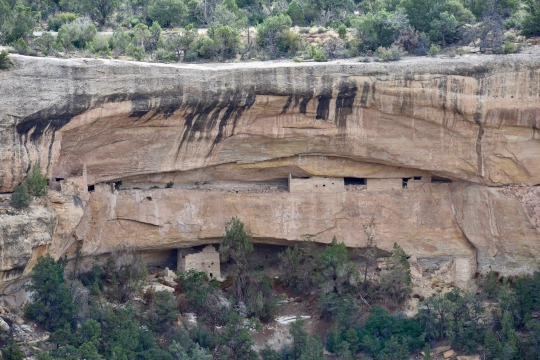
If you schedule in advance, you can get a guided tour to some of the ruins. We didn't do it, but we saw people who did:
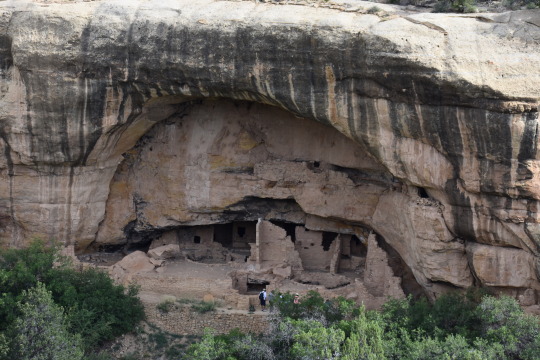
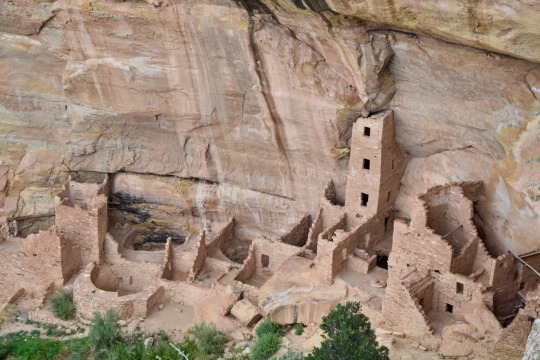
There are also plenty of mesas and canyons. Note that the structures pictured immediately above are just beyond the bend from the canyon pictured below.

In addition to the cliff dwellings, there are other, more traditional homes that are even older, some dating back to 600 A.D.
"These are much cooler than the sod house," said Luke, age 14, referring to the Prairie Homestead we saw earlier in South Dakota. "And much older."
"These took a little longer to build, I think," I responded.
--
Four Corners Monument, Teec Nos Pos, Arizona
At the geometric intersection of Arizona, Utah, Colorado, and New Mexico, on a reservation managed by the Navajo Nation, the Four Corners Monument is the only place in America you can stand in four states at once. Or sit. Or crabwalk. Or dribble a basketball. .
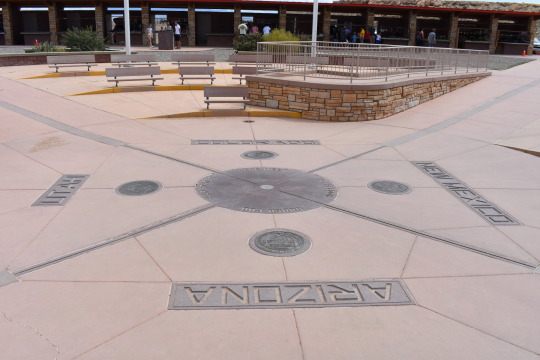
There was no basketball hoop at Four Corners, but Luke got his ball and dribbled it on the corner marker and in each state corner. For his creativity, he got applause from the line of people.
--
Wild Horses, maybe?
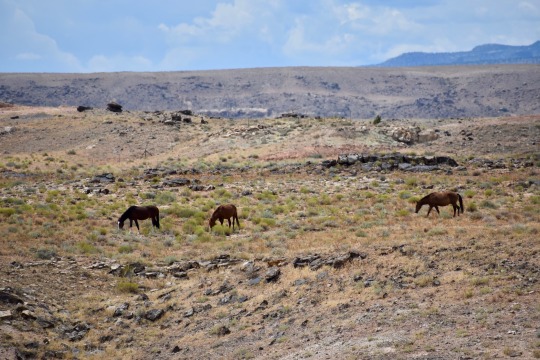
In New Mexico just outside Four Corners, we saw horses grazing in the distance. I have no idea if they qualify as "wild" horses, but there were no obvious ranches nearby.
Later, on our drive through Utah, we encountered a herd crossing the road and stopped for some photos.
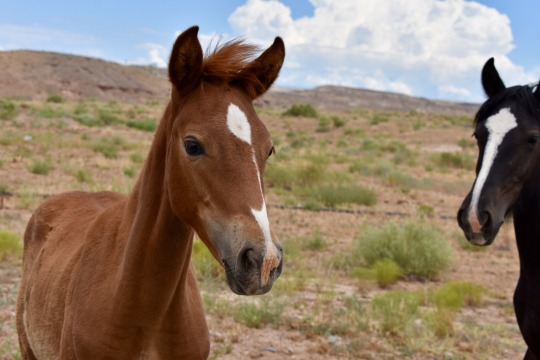
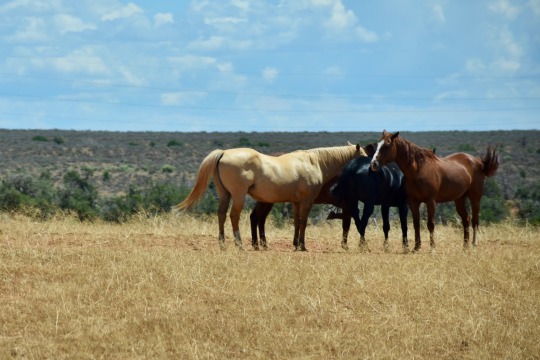
--
Arches National Park, Moab, Utah
It was 102°F outside and none of us were interested in hiking through mostly barren rock and desert under a blazing hot sun. However, we decided that we'd still drive into Arches just to see what we could.
The massive rock formations — arches, balancing rocks, pillars and more — did not disappoint. They're amazing. It's hard to convey their sheer otherworldly scale in a photograph, but you can see the size of the people and plants in some of the images.

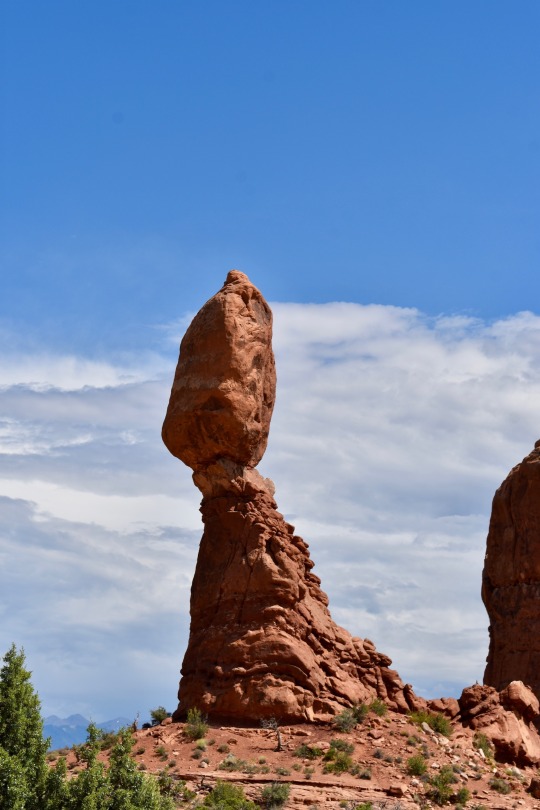

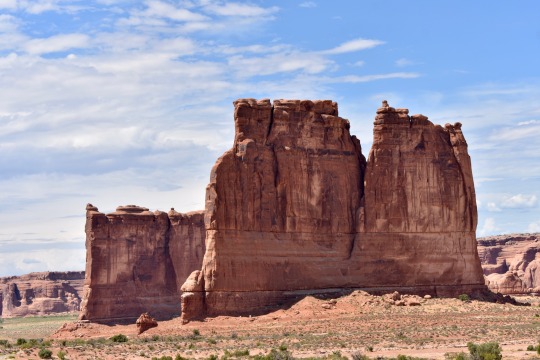
"It's like another planet," said Luke, age 14. "Like something out of a movie."
"It's places like this where Hollywood gets its ideas for other planets," I said.
We'd love to come back and hike around… during a cooler season.
--
Moab Isolation Center, Moab, Utah
Just up the road from Arches is the former site of the Moab / Dalton Wells Isolation Center: a concentration camp in which the U.S. government imprisoned Japanese Americans during World War II.
There is nothing left of it except two crumbling cement posts by the entrance, some cracked cement slab foundations, and a historical marker that has obviously been knocked over a few times.

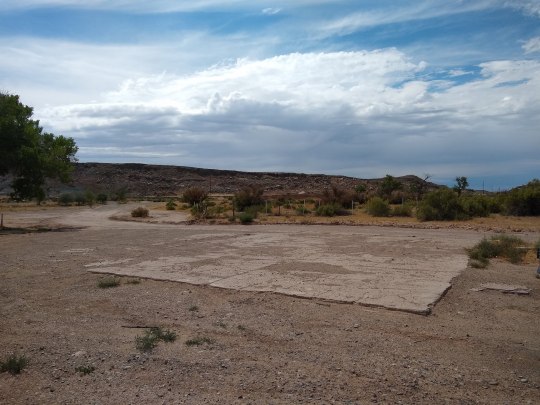

The historical marker minces no words about the Japanese imprisoned here:
“All these men were U.S. citizens; some were veterans of World War I, others were family men, college graduates, and responsible U.S. citizens. Their incarceration here is a vivid example of how our Japenese-American citizens were treated during World War II. May this sad, low point in the history of our democracy never be forgotten, in the hope that it will never happen again.”
There was a larger internment camp in Delta, Utah, which is now the Topaz Museum and which presents much more information on Japanese internment. We didn’t make it over there. And there were dozens of internment camps around the U.S., imprisoning thousands of people.
We had previously talked about the Japanese camps when they were mentioned at the Holocaust Museum in DC.
“I studied these camps in 8th grade,” said Luke. “All of these people lost their homes and businesses.”
“Pretty much. There are a few stories where, for example, other farmers kept up the farms of Japanese Americans and gave them back after the war,” I said.
“That’s really nice of them,” said Nora. “Everyone else just took their stuff.”
“I should point out that kind of humanity was not the norm,” I said.
As the marker notes, the site was previously a Civilian Conservation Corps (CCC) camp during the Great Depression. As part of FDR’s “New Deal,” the CCC was a voluntary work-relief program that gave young, unmarried men a job, income, shelter, and food during that period of massive unemployment. Apparently, the cottonwood trees by the Dalton Road entrance were planted by CCC workers.
--
On our way to our hotel for the night, we drove through a town called Dinosaur. It has street names like Brontosaurus and Stegasaurus. I was concerned that our hotel might feature goofy dinosaur artwork, but fortunately the dino theme was limited to a few children’s toys at check-in.
--
Unless noted otherwise, all photos and videos are taken by the kids and I, and are shared under the Creative Commons BY-NC-SA license.
#road trip#roadtrip#trip#parenting#travel#concentration camp#japanese#fatherhood#arches#geology#kids#dads#parenthood#child#children#childhood
2 notes
·
View notes
Text
Earthseed
Two issues which would make my earthseed community necessary are the climate crisis and global systems of White supremacy intrinsically tied to capitalism. The climate crisis disproportionately affects the global south which is most densely populated by Black and Brown communities, and White supremacy functions to disenfranchise and colonize Black and Brown bodies for labor. In light of these issues my earthseed community would band together sharing and cultivating mutual aid and resources as well as shielding and protecting one another from violence and subjugation at the hands of white suprmacists and the nation state. My earthseed community would be situated in the mesa verde national park which contains ancient Pueblo cliff dwellings. With the permission of the remaining indigenous Pueblos in the region, my earthseed community would form a coalition and learn indigenous stewardship practices from the Pueblos, as well as build our own housing nearby. In order to make the world a better place my earthseed group would follow and honor indigenous practices and dismantle capitalism, practicing communism and utilizing a bartering system. Through these practices we would aim to return the region to its state before settler colonialists arrived. Furthermore, the Mesa Verde national park contains various ecosystems and natural resources while remaining free from most natural disasters such as earthquakes, tornadoes and excessive fires or hurricanes. My earthseed community would be open to women, femmes, and all members of the trans community however cis gendered men, single men would not be allowed to travel with, or join the group due to their socialization as violent and patriarchal. However, if partnered they would be allowed to join. Additionally, my earthseed community would utilize AI drones to scan the mesa verde national park for approaching groups/ individuals. Once aware of outsiders, my earthseed community would gather together and approach the group as a united front. Furthermore, my earthseed group would confiscate all guns from individuals entering the territory and dismantle and discard them in a secure facility. Through disarming newcomers in the park, my earthseed group would created a safer and less violent landscape. My earthseed group would follow a democratic, popular vote leadership model in which each member held the power to draft a bill or proposition and each individual would vote. My earthseed model would not have representatives, only meeting leaders who would count the votes in front of the community to avoid corruption. One earthseed verse I would apply to my community is “your teachers are all around you. All that you perceive, all that you experience, all that is given to you or taken from you, all that you love or hate, need or fear will teach you.” This verse would teach my community to value the natural world and to have a patchy and appreciation to our peers and the knowledge of indigenous peoples. Another verse my community would utilize is “Belief initiates or guides action- or it does nothing.” This verse would represent the necessity of self motivation and the dangers of blindly following the teachings of others.
0 notes
Text
Things To Do in Colorado
Colorado is a state with a diverse array of activities to enjoy and many Colorado Body Rubs Centers. From outdoor adventures to cultural experiences, there's something for everyone in this beautiful state. Here are just a few of the many things you can do in Colorado:
Explore the Great Outdoors: Colorado is home to some of the most beautiful natural landscapes in the country. Take a hike in Rocky Mountain National Park to see majestic peaks and alpine lakes, or head to Garden of the Gods to see towering red rock formations.
Ski or Snowboard: Colorado is a winter sports paradise, with world-class ski resorts like Vail, Aspen, and Breckenridge. Whether you're a beginner or an expert, there's a slope for you to enjoy.
Take a Hot Air Balloon Ride: For a unique perspective on the state, take a hot air balloon ride over the Front Range. You'll get breathtaking views of the mountains and the city below.
Visit the Denver Art Museum: If you're interested in art and culture, the Denver Art Museum is a must-see. The museum has an extensive collection of American Indian art, as well as contemporary and modern art from around the world.
Go Whitewater Rafting: Colorado has some of the best whitewater rafting in the country. Take a guided trip down the Arkansas River or the Colorado River for an adrenaline-pumping adventure.
Take a Scenic Drive: Colorado is home to some of the most scenic drives in the country. Take a drive on the Million Dollar Highway, which winds through the San Juan Mountains, or on Trail Ridge Road, which takes you through Rocky Mountain National Park.
Sample Local Brews: Colorado is home to over 400 breweries, making it one of the top beer-producing states in the country. Take a brewery tour or visit a brewpub to sample some of the state's best beers.
Enjoy the Nightlife: Colorado has a vibrant nightlife scene, with music venues, bars, and clubs in cities like Denver and Boulder. Enjoy live music, dancing, and drinks with friends.
These are just a few of the many things you can do in Colorado. Whether you're an outdoor enthusiast or a culture lover, there's something for everyone in this beautiful state.
Colorado is a state located in the western United States, known for its beautiful mountains, scenic hiking trails, and outdoor recreational opportunities. Whether you're a nature lover, an adrenaline junkie, or a history buff, there are plenty of things to do and see in Colorado.
Hiking and camping in the Rocky Mountains: Colorado is home to some of the most breathtaking mountain ranges in the United States, including the Rocky Mountains. There are countless hiking and camping opportunities available, from easy nature trails to challenging mountain climbs. Some popular hiking destinations include Rocky Mountain National Park, Garden of the Gods, and the Maroon Bells.
Skiing and snowboarding: Colorado is also known for its excellent skiing and snowboarding, with many world-class resorts located throughout the state. Some popular ski resorts include Vail, Breckenridge, and Aspen.
Whitewater rafting and kayaking: Colorado is home to some of the best whitewater rafting and kayaking in the country, with rivers such as the Arkansas, Colorado, and Gunnison offering challenging rapids and beautiful scenery.
Fishing and hunting: Colorado is also a popular destination for fishing and hunting, with many rivers, lakes, and streams stocked with a variety of fish, and hunting areas for big game, small game, and waterfowl.
Visiting historic sites and landmarks: Colorado is also home to many historic sites and landmarks, including the Mesa Verde National Park, home to ancient cliff dwellings, the Black Canyon of the Gunnison National Park and Garden of the Gods Park.
Denver, the state capital, offers plenty of things to see and do, from visiting the Denver Botanic Gardens and the Denver Art Museum, to taking a tour of the State Capitol building and enjoying a night out on the town.
Hot springs: The state also offers many natural hot springs, like Glenwood Hot Springs, Iron Mountain Hot Springs, and Ouray Hot Springs.
In summary, Colorado is a state with a lot to offer for outdoor enthusiasts, Colorado BodyRubs history buffs, and anyone looking for a unique and exciting vacation. With an abundance of natural beauty, outdoor recreational opportunities, and historic sites and landmarks, Colorado is definitely worth a visit.
Colorado is a beautiful state with a variety of activities to suit any interest. Whether you're a nature lover, an adventure seeker, or a history buff, you'll find something to enjoy in Colorado.
Skiing and Snowboarding: Colorado is known for its world-class ski resorts. Some of the most popular include Vail, Aspen, and Breckenridge. Whether you're a beginner or an expert, you'll find a slope that suits your skill level.
Hiking and Camping: Colorado is home to some of the most beautiful natural landscapes in the country. The Rocky Mountains offer endless opportunities for hiking and camping, including the famous 14ers (peaks that are over 14,000 feet tall).
Whitewater Rafting: Colorado is also home to some of the best whitewater rafting in the country. The Arkansas River and the Colorado River offer a variety of rapids for all skill levels.
Hot Springs: Colorado is home to many natural hot springs. Some popular options include Glenwood Hot Springs, Ouray Hot Springs, and Mount Princeton Hot Springs.
National Parks: Colorado is home to several National Parks, including Rocky Mountain National Park, Great Sand Dunes National Park, and Black Canyon of the Gunnison National Park. These parks offer opportunities to see wildlife, hike, and explore the natural beauty of the state.
Visit Historic Towns: Colorado is rich in history and culture. Visit towns like Leadville, a former silver-mining town, or Durango, a historic railroad town, to learn about the state's past.
Denver: Denver, the state capital of Colorado, offers a variety of activities and attractions. Visit the Denver Botanic Gardens, the Denver Zoo, or the Denver Art Museum. Take a stroll down the 16th Street Mall, a pedestrian-friendly outdoor shopping and dining district.
No matter what your interests are, you'll find plenty of things to do in Colorado. The state's natural beauty, outdoor activities, and rich history make it a great destination for a vacation.
0 notes